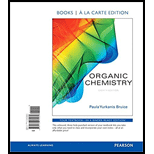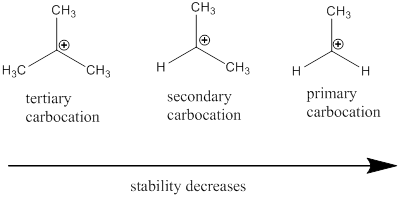
Interpretation:
The reaction of
Concept introduction:
Stereo selective: The reaction is considered as stereo selective if it gives rise to only specific stereo isomer.
Hydroboration reaction: The reaction involves addition of
Geometric isomers: Two compounds are considered as geometric isomers of each other if both contains same number of atoms but different in their arrangement that is compound is regarded as cis if identical substituents are placed on same side and trans if they are placed on the opposite sides.
R and S nomenclature: It is used to assign the molecule using CIP rules.
The CIP rules are as follows:
Select the chiral carbon and assign the numbers according to the decreasing
If the numbering follows clockwise direction then the molecule is termed as R and if it follows anti-clockwise direction then molecule is termed as S.
Carbocation: it is carbon ion that bears a positive charge on it.
Carbocation stability order:

Want to see the full answer?
Check out a sample textbook solution
Chapter 6 Solutions
ORGANIC CHEMISTRY (LL)-W/MOD.MASTERING.
- How many distinct alkene products are possible when the alkyl iodide below undergoes E2 elimination?arrow_forwardExplain the following result. Although alkenes are generally more reactive than alkynes toward electrophiles, the reaction of Cl2 with but-2-yne can be stopped after one equivalent of Cl2 has been added.arrow_forwardFollowing are diastereomers (A) and (B) of 3-bromo-3,4-dimethylhexane. On treatment with sodium ethoxide in ethanol, each gives 3,4-dimethyl-3-hexene as the major product. One diastereomer gives the E alkene, and the other gives the Z alkene. Which diastereomer gives which alkene? Account for the stereoselectivity of each -elimination.arrow_forward
- Treatment of 1-bromo-2-deuterio-2-phenylethane with strong base leads to a mixture of deuterated and nondeuterated phenylethylenes in an approximately 71 ratio. Explain.arrow_forwardThe following reactivity order has been found for the saponification of alkyl acetates by aqueous NaOH. Explain. CH3CO2CH3 > CH3CO2CH2CH3 > CH3CO2CH(CH3)2 > CH3CO2C(CH3)3arrow_forwardAcid-catalyzed hydrolysis of the following epoxide gives a trans diol. Of the two possible trans diols, only one is formed. How do you account for this stereoselectivity?arrow_forward
- The base-promoted rearrangement of an -haloketone to a carboxylic acid, known as the Favorskii rearrangement, is illustrated by the conversion of 2-chlorocyclohexanone to cyclopentanecarboxylic acid. It is proposed that NaOH first converts the a-haloketone to the substituted cyclopropanone shown in brackets and then to the sodium salt of cyclopentanecarboxylic acid. (a) Propose a mechanism for base-promoted conversion of 2-chlorocyclohexanone to the proposed intermediate. (b) Propose a mechanism for base-promoted conversion of the proposed intermediate to sodium cyclopentanecarboxylate.arrow_forwardElimination of HBr from 2-bromonorbornane gives only 2-norbornene and no 1-norbornene. How do you account for the regioselectivity of this dehydrohalogenation? In answering this question, you will find it helpful to look at molecular models of both 1-norbornene and 2-norbornene and analyze the strain in each.arrow_forwardExplain the formation of the main product of HBr addition to the compound 1-methyl cyclohexene without peroxide and in the presence of peroxide.arrow_forward
- Electrophilic nitration of benzoic acid gives almost exclusively 3-nitrobenzoic acid. By drawing the appropriate resonance forms of the intermediate cations resulting from attack of [NO2]+, explain this result.arrow_forwardChoose the right reagent or series of reagents from the ones listed below to prepare 2-pentanone from acetylene. NaNH2NaNH2 followed by CH3CH2CH2BrCH3CH2CH2Br, then disiamylborane followed by H2O2H2O2, HO−HO− H2H2, Lindlar followed by H2OH2O, H+H+ NaNH2NaNH2 and CH3CH2CHOCH3CH2CHO NaNH2NaNH2 followed by H2OH2O, H+H+ NaNH2NaNH2 followed by CH3CH2CH2BrCH3CH2CH2Br, then H2OH2O, H2SO4H2SO4, HgSO4 Choose one.arrow_forwardwhy do (R)-3-chloro-1-methylcycloprop-1-ene and 5-Bromo-1,3-Cyclohexadiene react differently with cyanide (why doesn't cyanide pass through its usual mechanism for these two products)arrow_forward

 Organic ChemistryChemistryISBN:9781305580350Author:William H. Brown, Brent L. Iverson, Eric Anslyn, Christopher S. FootePublisher:Cengage Learning
Organic ChemistryChemistryISBN:9781305580350Author:William H. Brown, Brent L. Iverson, Eric Anslyn, Christopher S. FootePublisher:Cengage Learning

